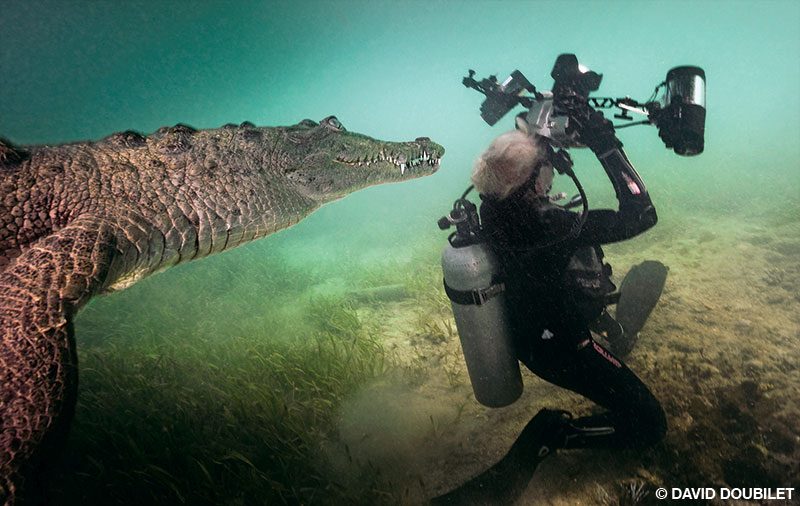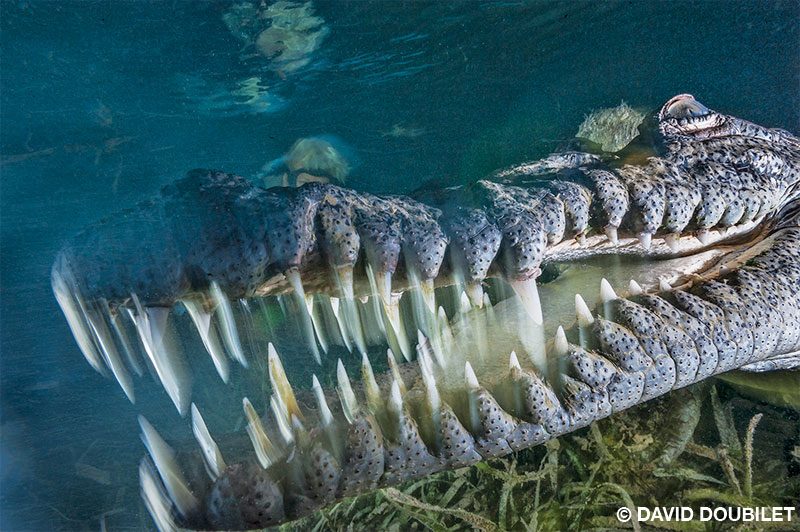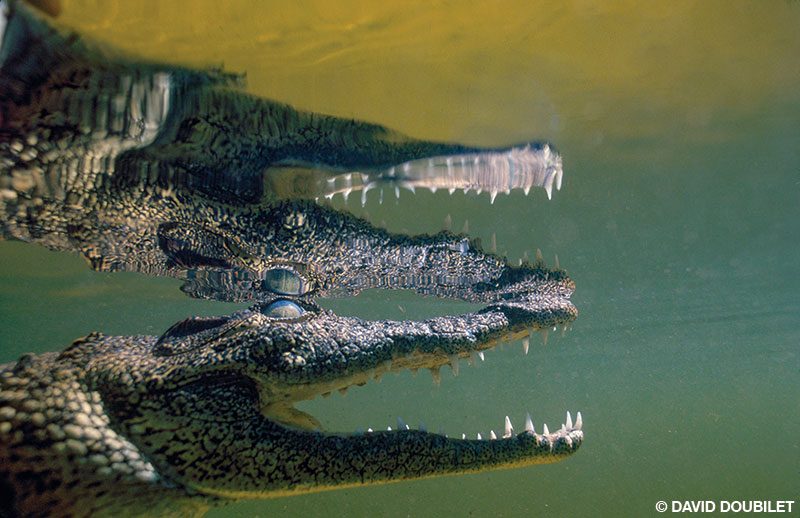Let me state this unequivocally: Crocodiles are apex predators, and in the wrong place and time, humans are potential prey. There are exceptions, but most of these wonderful and primitive reptiles won’t squander encountering a potential meal. When swimming in any reptile habitat, know who and what you may encounter, or don’t swim at all.
David Doubilet and I were on a National Geographic assignment in Cuba’s Jardines de la Reina (Gardens of the Queen) National Park. We had eight short shooting days to capture the magic of the long-ago Caribbean in this marine museum. With a “HEY!” noise through his regulator, David interrupted my obsession with a jelly floating above me. He swam toward me and fired off a series of strobe bursts that needed no interpretation.
I turned to find myself face to snout with an American crocodile. Greeting my unaggressive reptile visitor, I gave David a thumbs-up, burbled, “Hello, handsome! Look at you!” and captured its portrait. After a few frames, it was unimpressed with me and drifted downstream to do other crocodile things, and I returned to my jellyfish.

When some people see David’s image of the crocodile inches behind me, their reactions include wonder, awe, anger, horror and “How could he?!” — how could her husband take a picture and not save her? My answer is this: David gave the appropriate warning and quickly swam to me. I was a visitor in this creature’s environment, and in this circumstance there were more knowns than unknowns, so I did not feel threatened.
The resident American crocodiles (Crocodylus acutus) at Jardines de la Reina routinely share their waters with snorkelers and divers. I was fortunate to have an encounter with this symbol of an intact ecosystem that supports apex predators, and the image is an opportunity to discuss marine conservation. As journalists, we are careful never to suggest crocodiles are safe to swim with or let our images appear with sensational headlines that promote fear and loathing of marine life — and we have had many such requests.
I did not feel the same comfort working in Nile crocodile (Crocodylus niloticus) waters in Botswana’s Okavango Delta a decade earlier for a story called “Miracle Delta.” The story idea developed over a scotch in Washington when fellow wildlife photographer Frans Lanting remarked, “There is clear water for one month in the Okavango, and no one has looked closely beneath the surface there.” With unexplored places, there is always a reason why. In this case, there were two reasons: hippos and Nile crocodiles.
We were diving at Okavango Panhandle with our guides, Brad Bestelink and Andy Crawford, who taught us that large crocs sense your vibrations in the water and move in, hoping to find a new wildlife crossing. Keeping this in mind, we never dived the same place twice and never stayed for more than two hours. While we were photographing in a lily and papyrus garden that looked from below like a Monet painting, Brad signaled that our time was up. David responded with the familiar photographer’s plea for a little more time, just one more shot. Brad steeled his voice and said, “Out means out, David.” We pouted and moved well downstream to another spot.

Hours later, David asked to go back to the magical place for a night shot. Brad agreed, and we boated through the dark with spotlights on the bow. As we turned the bend, I exclaimed, “Holy hippo!” A giant hippo stood right where we had been working. Brad handed me his light, and we were astonished to see that the large figure was no hippo. A Nile crocodile more than 14 feet long had claimed the spot where we wanted to jump in. It was a very quiet ride back to the dock. Back in our lean-to, I not-so-calmly asked David, “What are we doing here? What were we thinking?”
Fast forward a few weeks, and we were armed with growing confidence, a local Shaman ceremony (for men only) to protect David from crocodiles and what must have been a glaring memory lapse. We learned about crocodile lairs beneath the papyrus mats — underwater hollows where crocodiles sleep. Our safe plan was to explore one at midday when the crocs were sunning themselves on the bank. The team swam into the chamber to find a white sand bottom, dark papyrus-root roof and meter-wide tunnels leading who knows where. I lit the chamber while David photographed the reptile living room, where dozens of croc prints half the size of my fin crisscrossed the floor. There were many places I would rather be than staring down the dark tunnel in front of me, so I signaled David to hurry.
A few nights later around the campfire we learned about the Zambezi catfish from a visiting ichthyologist. The Upper Zambezi squeaker (Synodontis woosnami), a species of upside-down catfish native to Botswana, is bright yellow with black polka dots and only comes out at night. Feeling that our story of Okavango would somehow now be incomplete without it, we planned a night dive in Nxamasere Channel to document this wonder of the African freshwater world.
We wrote out our squeaker plan, which began with a boat trip to the channel that runs into the main Okavango River. The three teams would be our boat team (one driver, one spotlight and one rifleman) and two dive teams: David with Brad and me with Andy. The guides would lead us and be entirely in charge of the dive with no exceptions.
Gearing up with an extra light, Brad also demonstrated the “croc stoppers” that each guide would carry. “It’s just a pointed stick,” I remarked, wondering how it would be useful against a crocodile. Brad replied, “If you see a croc, use it to kill yourself.” “Understood,” I answered. Our final instructions were to never swim near the edge of or underneath the papyrus under any circumstance and immediately surface if we heard gunshots, banging or the boat engine revving. We also had to beware of drifting too fast and getting swept into the main river — the boat team wouldn’t know it had happened, but the crocs would.

David and Brad rolled into the dark water first and disappeared quickly, and I momentarily thought, “He’s the National Geographic talent and had the anti-croc ceremony. Do I really need to go?” Conscience and curiosity took over as Andy and I did a giant stride through the Botswana night into the river.
Andy’s light made a pitifully small circle on the bottom. We sorted ourselves out, I pointed down my strobe arms, and we began to explore. A carpet of what looked like Vermont fall leaves littered the bottom. We drifted slowly, pulling away layers to expose the bottom, finally revealing yellow whiskers and a body with black spots. Here was the reason for being where we were and where we should not have been. Andy staked the croc stick in the sand, and we used it to brace ourselves in the current. I shot several frames before the squeaker swam off. We followed but quickly lost it.
Gauging our position, we shined the light upward to find a papyrus mat above us. We were inside a crocodile living room full of prints. Andy shined the light on her face, made a slicing gesture across her throat and began swimming back. We just cleared the chamber when we heard the engines revving nonstop and the unmistakable sound of metal hitting metal. We filled our buoyancy compensators and shot up the 10 feet to the surface.
I managed to blurt out, “What is…” as the boat team pulled us up by our hoods and hair, no ladder involved and without explanation or apology. Brad and David were already on board. We had drifted too fast and were yards from entering the river. The boat spotlight revealed many sets of blazing red eyes on the bank at the end of the Nxamasere Channel, right where we would have ended up.
Fortunately, we got what we came for without incident and succeeded in publishing our shots of the Zambezi squeaker. Underwater in the Okavango Delta is a magical place filled with dreams and danger. It should never be considered a dive destination, but save your money and consider taking a safari there. It will touch your soul.
© Alert Diver — Q1 2021